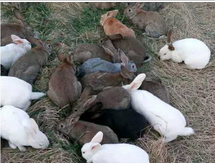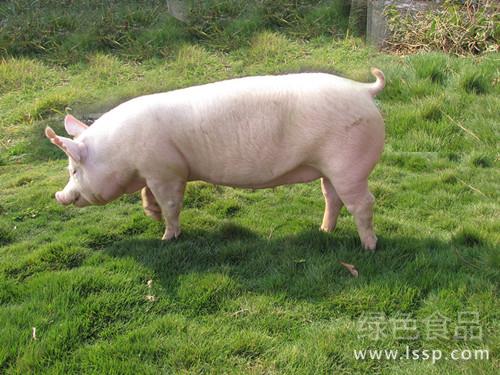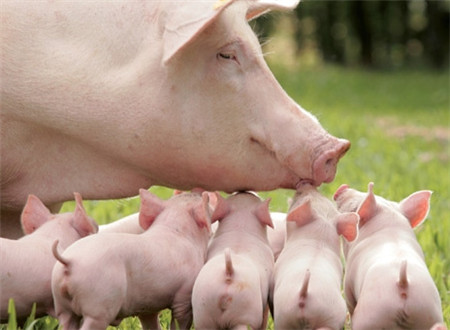What are the specific aspects of the nutritional imbalance of female rabbits?
Basic nutrition imbalance female rabbit nutrition imbalance is shown in three aspects: lack of nutrition, excess nutrition, nutrition imbalance.
Lack of nutrition: the nutritional value of feed is low or the amount of feed given every day is insufficient, which can not guarantee the nutritional needs of the female rabbit, and the female rabbit will have symptoms such as rough coat, thin body, arched back and so on. When the female rabbit is too thin, the endocrine system is affected, gonadal secretion imbalance, non-estrus or estrous cycle prolonged; at the same time, the uterine mucosa is very thin, even if matched, it is not easy to sit on the fetus. When the nutrition level is too low, the secretion of gonadotropin-releasing factor in hypothalamus is inhibited, and the secretion of other hormones is also affected. Endocrine disorders affect embryo survival, resulting in a decline in reproduction rate.

Overnutrition: the nutritional level of feed is too high, or the amount of feed is often excessive, making the female rabbit too obese. The fat content of the overweight female rabbit is high, the fat deposit in the fallopian tube wall is more, and the elasticity becomes smaller, so it is difficult for the egg to move to the ampulla of the fallopian tube, which hinders the combination of sperm and egg.
Nutritional imbalance: the proportion of protein, fat and carbohydrates in feed should be reasonable, otherwise it will affect the feeding effect. Take the Rex rabbit as an example, the feeding standard is 17%-18% crude protein, 3%-5% crude fat, 10-11 megajoules per kilogram of feed and 12%-15% crude fiber. If the amount of corn is large (the digestible energy per kilogram of feed reaches 12 megajoules) and the amount of protein feed is small (crude protein is less than 15%), the breeding rate of breeding rabbits will be reduced.
Vitamin deficiency vitamins related to reproduction are vitamin A, vitamin D, vitamin B1 and vitamin E.
Vitamin A: vitamin A plays an important role in the growth and development, reproduction and disease resistance of rabbits, and is an indispensable substance to maintain the normal epithelial cells of various tissues and organs. Lack of vitamin A leads to keratinization of epithelial cells of reproductive organs and dysfunction of the reproductive system.
Vitamin D: vitamin D can promote the absorption of calcium and promote the growth of rabbits. If lack, the rabbit will appear osteoporosis, reproductive ability is hindered phenomenon.
Vitamin E: vitamin E, also known as tocopherol, plays an antioxidant role in rabbits and can prevent the oxidation of unsaturated fatty acids in the body. When vitamin E is deficient in rabbits, the unsaturated fatty acids in rabbits are oxidized too much and produce too many peroxides, which can cause pathological changes in the morphology and function of reproductive organs, destroy germ cells and cause reproductive disorders.
Vitamin B1: vitamin B1, also known as thiamine, is the coenzyme part of ketoacid oxidation and decarboxylation in glucose metabolism in rabbits. When vitamin B1 is deficient, the metabolism of pyruvate is blocked, which causes pyruvate accumulation in the brain and blood, causing poisoning. Due to the obstruction of glucose metabolism and insufficient energy supply, resulting in neurological dysfunction, female rabbits will have ovarian atrophy, stagnation of follicular development, empty pregnancy after embryo absorption, stillbirth and abortion in pregnant female rabbits. after giving birth, the vitality of the child rabbit is weak, the milk production is decreased and so on.
- Prev

Nutritional requirements and feeding of healthy pregnant sows with adequate nutrition
Nutritional requirements and feeding of healthy pregnant sows with adequate nutrition
- Next

The sow is due 7 days too late? The veterinarian taught you how to avoid the death of piglets!
The sow is due 7 days too late? The veterinarian taught you how to avoid the death of piglets!
Related
- On the eggshell is a badge full of pride. British Poultry Egg Market and Consumer observation
- British study: 72% of Britons are willing to buy native eggs raised by insects
- Guidelines for friendly egg production revised the increase of space in chicken sheds can not be forced to change feathers and lay eggs.
- Risk of delay in customs clearance Australia suspends lobster exports to China
- Pig semen-the Vector of virus Transmission (4)
- Pig semen-the Vector of virus Transmission (3)
- Five common causes of difficult control of classical swine fever in clinic and their countermeasures
- Foot-and-mouth disease is the most effective way to prevent it!
- PED is the number one killer of piglets and has to be guarded against in autumn and winter.
- What is "yellow fat pig"? Have you ever heard the pig collector talk about "yellow fat pig"?

